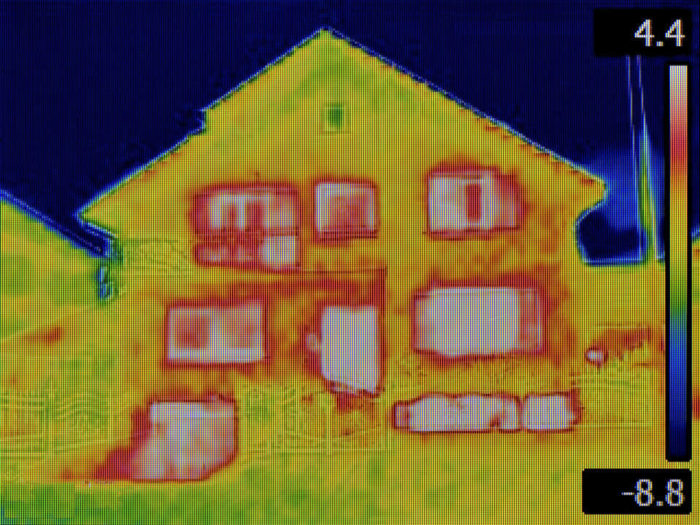
Image Credit: iStock
Have you ever wanted X-ray vision, or to see the hidden features of your home? The City of Vancouver has launched a new effort to make energy use more visible to its residents, complete with rainbow-colored images of their homes that show details invisible to the naked eye. Using thermal imaging to show heat loss in roughly 15,000 homes in five neighborhoods, Vancouver aims to help residents uncover wasted energy.
The allure of invisibility has been with us for a long time. Stories ancient and modern have explored the idea, introducing us to Harry Potter’s cloak, James Bond’s invisible car, and of course Frodo’s ring. But some things are already invisible in ways that create real problems. Homeowners want energy-efficient homes, but they can’t easily tell the difference between an efficient and inefficient home. The invisibility of energy use creates transparency problems in the market, and these problems are starting to be addressed in a variety of ways.
Infrared thermography
Vancouver’s program is based on infrared thermography (IRT) of each of the 15,000 homes. IRT is a way of taking pictures that show the heat emitted from objects. This creates an image of temperatures, warm and cold, instead of the colors and shadows that we see with our naked eyes or in standard photography. This is great way to find areas of heat loss in a home, essentially providing a guide to the parts of a home that cause discomfort and require the furnace, boiler, or air conditioning system to work harder and consume more energy to meet temperature demands. Thermography can also reveal materials with water damage, since those hold heat differently than dry materials.
Thermographic images also are recognizable for being colorful and distinct. By revealing invisible heat loss and allowing a new way of seeing one’s home, these images have the allure of a new technology. And although thermographic images have been around for some time, IRT cameras are becoming more common and inexpensive.
Portable versions made to be a smart phone accessory retail for $250, compared with the $14,000 price that professionals had to pay only 10 years ago. Now a collection of 10 neighbors could purchase one to share for only $25 each. But to get the most out of it, they would need to learn how to use it well. Professional thermographers know sophisticated techniques and understand the limitations of the technology.
One limitation of IRT for home assessment is that it requires at least a 30-degree difference between indoor and outdoor temperatures to work best. Without such a difference, the heat loss through the structure may not be apparent. This is why Vancouver’s pilot is being run over the winter.
Programs like Vancouver’s are further limited by only capturing images of a home’s front and side, which won’t reveal heat loss from other areas. This approach is a result of using car-mounted cameras to scan entire neighborhoods, but it may produce false negatives. For example, a scanned home may appear to have no heat loss if heat was primarily leaking from the back of the building.
The primary purpose of the pilot is to test a variety of approaches, including comparing homeowner response to letters with IRT images to those without to see if the images motivate more residents to take action. According to Chris Higgins, Green Building Planner with the City of Vancouver, they are testing a variety of approaches in the pilot and will have public results available in spring of 2018.
The economics
Vancouver’s pilot program will cost approximately $6 per home. The question is, how much will it drive energy-upgrade actions among those homeowners? Essess, the company delivering the program for Vancouver, has performance results from similar programs in the past. According to a 2015 Navigant study, a similar program resulted in 3.8% of households responding to a mailer containing a thermographic image of their home. This response rate was two to four times greater than the usual response rates of other utility programs.
If we assume that 2% of homeowners, or roughly half of those who respond, take action and are converted into project leads, then the Vancouver program works out to have a cost of roughly $300 per project lead. A cost of $300 per lead is common for the home improvement industry, or maybe even a little low. If those homeowners take actions that work out to an average of $1,000 in activity on each home, either by hiring contractors or by spending equivalent sums to do it themselves, then this campaign would generate roughly $300,000 in economic activity — a three-to-one multiplier for the program costs. Higgins says that if the pilot results in a $300 cost to get residents to take action, they’d consider that a success.
What this means for the industry
Research has shown that a direct mail campaign using a house list (an internal mailing list for existing customers) has an average response rate of 3.7%. Given that the city has an existing relationship with its residents, the 3.7% response rate for “existing customers” should be a fair comparison baseline for IRT-enhanced direct mail.
The average response rate research comes from a 2015 report from the Data & Marketing Association, chosen since the Navigant study referenced above was also from 2015. Since regular direct mail for house lists had a nearly identical response rate to the IRT-enhanced outreach in 2015, it will be useful for the industry to see Vancouver’s pilot results with a direct control group.
If the response rates remain the same, this may imply that the primary benefit of thermography programs is in the personalized approach they deliver for each home, more than the thermography itself. Whether the specific analysis or the colorful pictures drive more residents to take action remains to be seen. Essess has been working on improving how it delivers its services, and the Navigant study is several years old. Moreover, having cities lead efforts like Vancouver’s may produce very different results from having utilities lead such efforts, given that residents’ trust relationships can be very different with city governments and utilities.
Measuring the success of the Vancouver program should provide important insights into what this approach can deliver.
The other question is not just whether thermography programs can reach more homes, but whether they can reach different homes. Does the highly visual image, with its new-technology glamour, reach a different audience from traditional efficiency marketing? If so, then the number of homes reached could remain comparable to other programs but still represent a major breakthrough.
Mimicking the solar contagion effect
The neighborhood sweep approach for this program brings an additional component to efficiency marketing: social norms and peer pressure. By focusing on an entire neighborhood at a time and publicly sharing that approach (though not publicly sharing information about individual homes), the program has a greater chance of building on word of mouth and social norms for the neighborhood.
Neighborhood thermography could support growth of efficiency efforts similar to that produced by the solar contagion effect. Also, as real estate listings continue to capture more information about homes and home energy, thermal imaging could provide a new aspect of information about neighborhoods and individual homes.
To improve the social norm impact of thermal imaging programs, we would recommend adding an image of a high-performing home as a point of comparison. This would help define what’s possible and highlight the deficiencies in the current home. Ideally, this high-performing home image could be drawn from the same neighborhood. This would require getting the high-performing homeowner’s permission, of course, but would create an opportunity to highlight champions in the neighborhood and engage the early adopters who may not have much interest in the program otherwise.
Home energy efficiency will never have a silver bullet that engages all residents. Rather, moving the market requires what energy mavens have long called “silver buckshot,” a variety of approaches that solve a variety of problems. Thermography-based programs may help reach more households, or different households, by providing a personalized, visually striking analysis of people’s homes.
Jacob Corvidae is a manager in the Rocky Mountain Institute’s Buildings Practice. © 2017 Rocky Mountain Institute. Published with permission. Originally posted on RMI Outlet.
Weekly Newsletter
Get building science and energy efficiency advice, plus special offers, in your inbox.













5 Comments
I really do need to replace all of my windows however
I'd have to go full frame which is major $$$$$$$$$$$$
Investment $ vs. energy savings results
The emphasis here on effectiveness on getting people to spend money on upgrades is a little strange. It should be more on getting energy savings results. If this and some other marketing effort both get 3% of the homeowners to spend money on energy upgrades, but with this approach it's the ones who need it the most, then the energy savings results from this will be much greater.
There's a lot more work to figure out how to tease out the real opportunities from from images, but you are unlikely to make progress on that if your main focus is on getting people to spend money rather than fixing energy problems.
Clarification
Hi Charlie, Thanks for the comment. You're absolutely right that the primary focus for the Vancouver program and others like it is, and should be, to achieve energy savings. My intention with the economic analysis was not imply that the purpose of such a program is to get people to spend money. However, Vancouver is ahead of many cities in their climate action commitments, and many cities might see spending $300 / project to be a high cost to drive climate action when they consider the large scale of their populations. Climate programs are naturally in competition with all of the other interests calling for investment in cities. My point here was to clarify that this kind of investment has multiple benefits. For better or worse, most cities must weigh their budgeting priorities against the question of whether budget spends will build up economic activity in the city or detract from it. For that reason, highlighting the economic activity becomes important for other city staff to consider.
Window Replacements
Hi John,
You may have to replace all of your windows, but many older windows can stop their heat loss with much less expensive measures. Focusing on air sealing any drafts around the windows, including the framing, can make a big difference. Also, adding well install storm windows, or other approaches that create a second barrier with an air layer between the old window and new layer can prevent a lot of heat loss as well. While this won't be as good as high performing new windows, it can make a significant difference in heat loss if you don't have the money for new windows.
@Jacob
Thanks for the input. We have 17yr old double-hung wood framed windows. I'd gather that a majority of them have rough openings that are too small or out of square. I've reinstalled weather-stripping underneath the sashes and managed to squeeze a piece of foam between the sash and the interior ledge on the worst windows because you could see daylight peek between the sash and the sill.
Oh and doors as well. I can see plenty of daylight at the bottom corner of the doors.
In typical late-90's production builder fashion my rough openings for the windows and doors were not done correctly. I doubt there's even insulation behind the framing around the windows.
I have to stop now and get some water because I'm now starting to get really pissed thinking about this stuff. lol
Log in or create an account to post a comment.
Sign up Log in